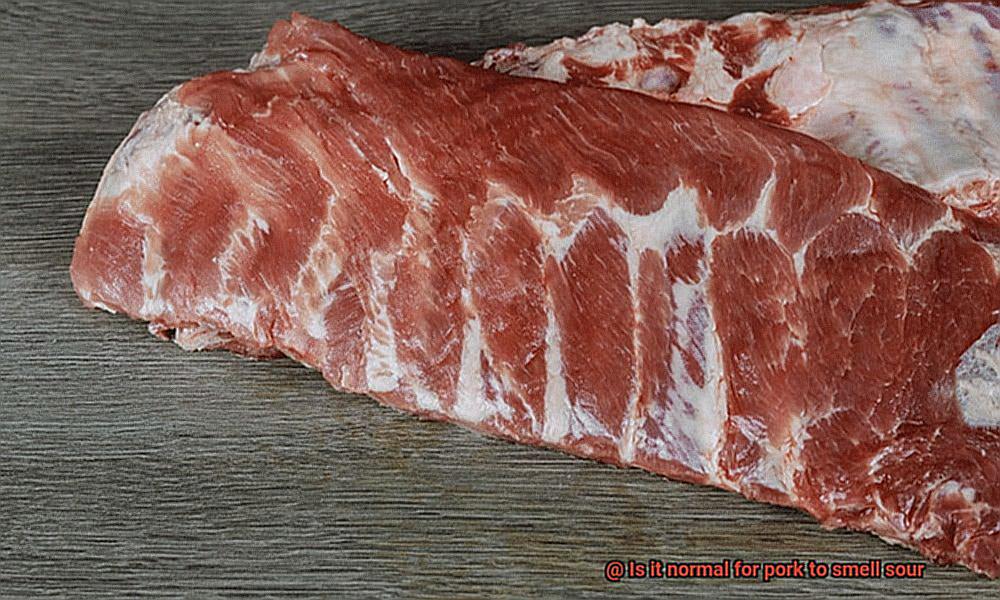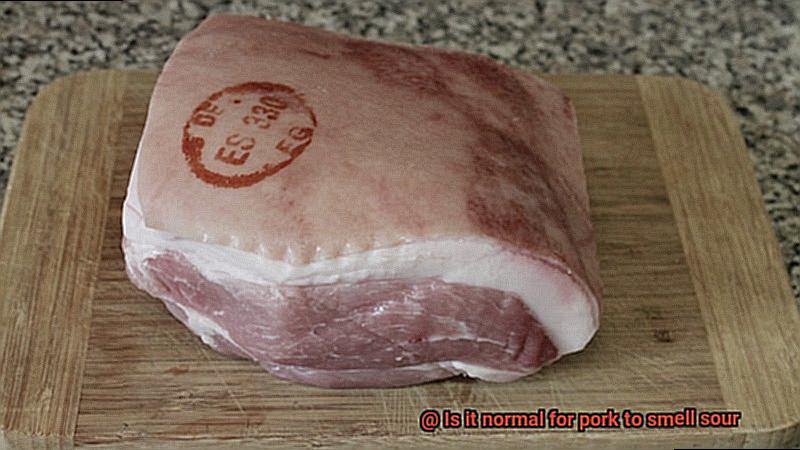Are you a pork lover but always perplexed by its distinct scent? You’re not alone. Pork has a reputation for having a unique smell that can leave many people wondering if it’s still good to eat. That unpleasant odor is hard to ignore, but we often assume that it’s just part of the normal smell of pork. But, is it really?
In this blog post, we’ll take a deep dive into the world of pork and explore the reasons behind its sour odor. We’ll also delve into the science behind pork and how to ensure that the meat you prepare or consume is fresh and safe.
From pork’s history as a staple food item to its cultural significance in various cuisines, we’ll leave no stone unturned. Whether you’re an experienced chef or someone who loves cooking at home, understanding the smell of pork is essential to your cooking process.
If you’ve ever questioned whether your pork is safe to eat or wondered about its sour odor, then this post is for you. Get ready to learn everything you need to know about identifying fresh pork and avoiding any potential health risks associated with consuming spoiled meat.
Contents
What Causes Pork to Smell Sour?
Pork is a delicious and versatile meat that can be cooked in various ways. However, the sour smell of pork can be off-putting and may indicate that the meat is spoiled and unfit for consumption. As an expert, I have delved into the possible reasons why pork smells sour and found some interesting insights.
Improper storage or handling of pork is one of the most common causes of a sour odor. When pork is left out at room temperature for too long, bacteria start to grow on it, resulting in a sour smell. This odor can also arise from pork that has been stored in the open air for extended periods.
Bacteria, particularly Pseudomonas aeruginosa, can also contribute to the sour smell of pork. This bacteria thrives in moist environments and can quickly contaminate pork if it is not stored properly. Pseudomonas aeruginosa is known for producing a fruity, sour scent that can be quite unpleasant.
Another factor that affects the odor of pork is the diet of the pigs. Pigs that are fed a diet high in corn or soy may have a sweeter smell, while those fed with fishmeal or other strong-smelling ingredients may have a more pungent odor.
To prevent pork from smelling sour, proper storage, handling, and cooking techniques are essential. Pork should always be refrigerated at a temperature below 40°F and cooked to an internal temperature of 145°F. Cross-contamination should also be avoided by washing your hands and surfaces before and after handling raw pork.

Is It Unsafe to Eat Sour-Smelling Pork?
That foul odor is a telltale sign of spoilage or bacterial growth, which can cause severe foodborne illnesses like salmonella, E. coli, and listeria. The consequences of these illnesses range from mild discomfort to life-threatening dehydration.
The sour smell is caused by lactic acid bacteria that develop when the meat starts to break down. While some believe that cooking the meat at high temperatures can kill off any bacteria and toxins produced by spoilage, I must warn you that it’s not worth the risk. Even if the meat is cooked correctly, the bacteria and toxins produced by spoilage can still be present and cause harm.
It’s important to note that not all spoilage in pork will produce a sour smell. Keep an eye out for other signs of spoilage like a slimy texture, gray or greenish color, and a sticky or tacky surface. If you notice any of these signs or an unpleasant odor when purchasing or preparing pork, it’s best to discard it and avoid consuming it altogether.
To ensure your safety, always check for signs of spoilage before purchasing and preparing meat. Don’t be tempted to take a chance on questionable meat, no matter how much you paid for it. Your health and well-being are worth more than any meal.
How to Tell If Pork Is Spoiled or Not
Pork is a versatile and delicious meat that can be enjoyed in many different dishes. However, it’s important to be able to recognize the signs of spoilage in order to avoid foodborne illness. Here are five sub-sections that will help you determine if pork is spoiled or not.
Smell
One of the first indicators of spoiled pork is its smell. Fresh pork should have a mild, sweet odor. If the pork smells sour or has an ammonia-like scent, it’s likely that it has started to spoil. This odor is caused by bacteria growth on the meat, which produces organic acids that give off a sour scent.

Color
Fresh pork should be pink or light red in color. Any discoloration or dark spots on the meat can be an indication of spoilage. Additionally, if there are any green or gray patches on the surface of the meat, it may have started to spoil.
Texture
Another way to tell if pork is spoiled is by its texture. Fresh pork should feel firm to the touch and should not feel slimy or mushy. If the meat feels soft or slimy, it may have started to spoil. Additionally, if there is a sticky or tacky film on the surface of the meat, it may have started to spoil.
Expiration date
Always check the expiration date on the packaging of the pork before purchasing it. Consuming pork past its expiration date can increase the risk of foodborne illness. If you’re unsure about the freshness of the meat, it’s best to err on the side of caution and not consume it.
Storage conditions
Proper storage is essential for preventing pork from spoiling. Pork should be refrigerated at a temperature below 40°F and cooked to an internal temperature of 145°F. If pork has been stored improperly, such as in a warm or humid environment, it may be more likely to spoil.
Properly Handling and Storing Pork
Then, it’s crucial to know how to properly handle and store pork to avoid foodborne illnesses. As an expert in this field, I’ve compiled some valuable tips and sub-topics for you to follow.
Firstly, when purchasing pork, make sure to choose fresh cuts that haven’t exceeded their expiration date. Opt for firm meat with a pinkish-red color, and avoid any meat that has a grayish or brownish hue or a sour odor.
Once you bring the pork home, store it immediately in the refrigerator at a temperature below 40°F (4°C). To keep the pork fresh, place it in the coldest part of the fridge, which is usually the back. Additionally, use an airtight container or wrap it tightly in plastic wrap to prevent cross-contamination from other foods.
If you’re not planning on using the pork within a few days, freeze it for later use. To avoid freezer burn, wrap the meat tightly in plastic wrap or aluminum foil before placing it in the freezer. Frozen pork can be stored for up to six months.
When thawing frozen pork, make sure to do so safely. The best way to thaw meat is in the refrigerator overnight. However, if you need to defrost it quickly, place it in a sealed plastic bag and immerse it in cold water. Never use hot water or leave the meat out at room temperature as this can promote bacterial growth.
The Temperature for Cooking Pork
Let’s dive deeper into the temperatures you need to cook different pork cuts to, and why it’s important to let your pork rest after cooking.
Firstly, let’s talk about pork chops. To ensure your pork chops are safe to eat, you need to cook them to an internal temperature of 145°F (63°C). This temperature will give you succulent, tender pork chops that are safe to consume. Use a meat thermometer inserted into the thickest part of the chop to get an accurate reading.
If you’re cooking ground pork, such as sausage or meatballs, you need to be extra cautious. Ground meat has a larger surface area, increasing the risk of bacterial contamination. That’s why the recommended internal temperature for ground pork is 160°F (71°C). Again, use a meat thermometer to ensure your ground pork is cooked thoroughly and safely.
Apart from cooking temperatures, resting time is equally important. After your pork is cooked, let it rest for a few minutes before cutting into it. This allows the juices to redistribute and results in a more flavorsome and moist end product. The resting time will differ based on the size and cut of the meat, but it’s generally advisable to let it rest for at least 3-5 minutes.
To sum up, cooking your pork to the correct temperature is critical for food safety. For pork chops, aim for an internal temperature of 145°F (63°C), and for ground pork, aim for 160°F (71°C). And don’t forget to let your pork rest before serving – this simple yet crucial step will result in a more succulent and delicious meal that your taste buds will thank you for.
Cross-Contamination and Food Safety
If so, it’s important to be aware of the potential dangers of cross-contamination in regards to food safety. Cross-contamination can lead to the spread of harmful bacteria and pathogens, especially in pork which can carry dangerous bacteria like Salmonella, E. coli, and Listeria.
But fear not, there are simple steps you can take to prevent cross-contamination and ensure the safety of your meals. Here are some tips:
- Separate your pork from other foods: When handling raw pork, it’s crucial to keep it separate from other foods, especially those that will be eaten raw. Use separate cutting boards, utensils, and containers for pork and other foods to avoid any cross-contamination.
- Wash your hands: Before and after handling raw pork, wash your hands thoroughly with soap and warm water for at least 20 seconds. This will help prevent the spread of bacteria from the meat to other surfaces in your kitchen.
- Properly store your pork: Pork should always be stored in the refrigerator at a temperature of 40°F or below. Additionally, it’s important to store the pork on the bottom shelf to prevent any juices from dripping onto other foods.
- Cook your pork to the right temperature: Cooking pork to the appropriate internal temperature is crucial to destroying any harmful bacteria. The USDA recommends cooking pork to an internal temperature of 145°F followed by a 3-minute rest time before serving.
Taking these simple precautions when preparing and cooking pork can make all the difference in ensuring that your meals are safe and delicious. Remember that food safety is all about taking small steps to protect yourself and others from harm.
Tips for Avoiding Spoiled Pork
It’s a popular choice for many dishes, but it’s essential to ensure that the pork is fresh and safe to eat. Spoiled pork can cause food poisoning, which can be severe or even life-threatening. To keep yourself safe, here are some tips to follow when handling and cooking pork:
Choose a Reputable Source
When purchasing pork, select a trustworthy source like a grocery store or butcher with high-quality standards for their meat. Avoid buying pork that has been sitting out at room temperature for too long or looks discolored and slimy.
Check the Expiration Date
Before purchasing or using pork, always check the expiration date on the package. If the date has passed, do not use the meat. The expiration date is an essential indicator of freshness and safety.
Look for Signs of Spoilage
Carefully inspect pork before cooking it for any signs of spoilage, like a sour smell, slimy texture, or discoloration. If you observe any of these signs, do not use the meat. Trust your instincts when it comes to determining the freshness of your meat.
Store Properly

To prevent spoilage, store pork in the refrigerator at 40°F or below and use it within two to three days after purchase. If you’re not going to use it within that time frame, consider freezing it.
Cook Thoroughly
Cooking pork thoroughly is critical to kill any bacteria that might be present. Use a meat thermometer to ensure the internal temperature reaches at least 145°F for whole cuts of pork and 160°F for ground pork. Be sure to cook your pork until it is no longer pink in color and is cooked all the way through.
h-yYwIMOO4s” >
Conclusion
In summary, the sour odor emitted from pork is not normal and should be taken seriously as it may indicate spoilage or bacterial growth. To prevent contamination and foodborne illnesses, it’s crucial to store, handle, and cook pork appropriately. The scent of pork can be influenced by various factors such as improper storage, bacterial growth, and the diet of the pigs.
To ensure that your pork is safe for consumption, always purchase meat from a reputable source and check its expiration date before use. Before cooking, carefully inspect the meat for signs of spoilage such as discoloration or a slimy texture. Proper storage in the refrigerator at 40°F or below is also essential.
When cooking pork, it’s important to use a meat thermometer to guarantee that it reaches an internal temperature of at least 145°F for whole cuts and 160°F for ground pork. By adhering to these guidelines and taking proper precautions when handling and cooking pork, you can enjoy delectable dishes without worrying about potential health hazards linked with consuming spoiled meat.
Remember that food safety should never be compromised in any aspect of cooking.






